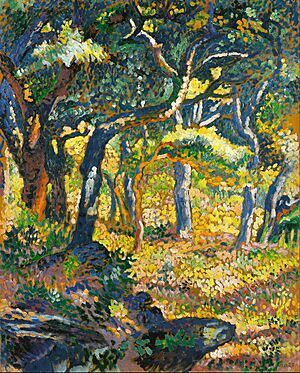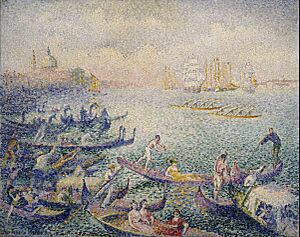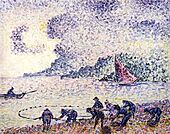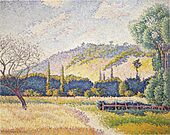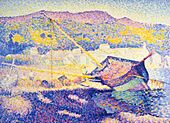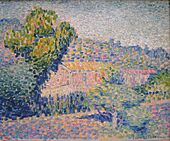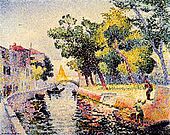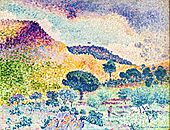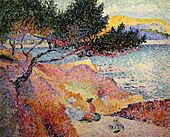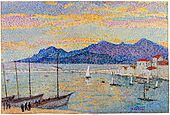Henri-Edmond Cross facts for kids
Quick facts for kids
Henri-Edmond Cross
|
|
|---|---|
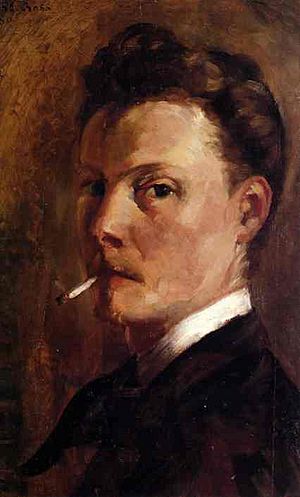
Self-Portrait with Cigarette, 1880
|
|
| Born |
Henri-Edmond-Joseph Delacroix
20 May 1856 |
| Died | 16 May 1910 (aged 53) Saint-Clair, Var, France
|
| Known for | Painting |
| Movement | Neo-Impressionism, Pointillism, Divisionism |
Henri-Edmond Cross, born Henri-Edmond-Joseph Delacroix, was a French painter and printmaker (born May 20, 1856 – died May 16, 1910). He is best known as a master of Neo-Impressionism, an art style where paintings are made from many small dots or strokes of color. He played a big part in developing this art movement and greatly influenced famous artists like Henri Matisse. His work was also very important in the early days of Fauvism, another art style known for its strong, bright colors.
Contents
Early Life and Art School
Henri-Edmond-Joseph Delacroix was born in Douai, a town in northern France, on May 20, 1856. He was an only child. His family had a history of working with iron. His father was Alcide Delacroix, and his mother was Fanny Woollett from Britain.
In 1865, his family moved near Lille, a city close to the Belgian border. Henri's artistic talent was noticed by his father's cousin, Dr. Auguste Soins. Dr. Soins was very supportive and even paid for Henri's first drawing lessons in 1866. His teacher was the painter Carolus-Duran. Henri studied with Duran for a year.
He continued his art studies in Paris for a short time in 1875 with François Bonvin. After that, he returned to Lille. He studied at the École des Beaux-Arts and later at the Écoles Académiques de Dessin et d'Architecture from 1878 to 1881. In 1881, he moved back to Paris and continued his art education with Émile Dupont-Zipcy, another artist from Douai.
Becoming a Neo-Impressionist Painter
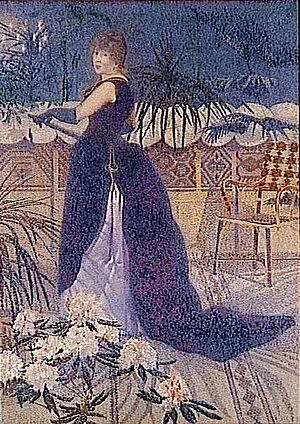
Cross's first paintings were mostly portraits and still lifes. They used dark colors, typical of the Realism art style. In 1881, he changed his name to "Henri Cross" to avoid confusion with the famous Romantic painter Eugène Delacroix. The French word croix means cross.
In 1881, he had his first art show at the Salon des Artistes Français. In 1883, he traveled to the Alpes-Maritimes with his family and painted many landscapes. During this trip, he met Paul Signac, who became a close friend and influenced his art.
In 1884, Cross helped start the Société des Artistes Indépendants. This group was for artists who didn't like the traditional art shows. They held exhibitions where anyone could show their art without a jury. Here, Cross met many artists from the Neo-Impressionist movement, like Georges Seurat and Paul Signac.
Even though he was friends with Neo-Impressionists, Cross didn't paint in their style right away. His early work was influenced by artists like Jules Bastien-Lepage and Édouard Manet. He also started using brighter colors, like the Impressionists, and painted outdoors. By the late 1880s, his landscapes showed the influence of Claude Monet and Camille Pissarro. Around 1886, he changed his name again to "Henri-Edmond Cross" to avoid confusion with another artist named Henri Cros.
In 1891, Cross finally began painting in the Neo-Impressionist style. He showed his first large painting using this technique at an Indépendants show. This painting was a divisionist portrait of Madame Hector France, whom he married in 1893. This painting was described as "softly charged with a granular, atmospheric glow."
Cross had been spending winters in the south of France since 1883 because he suffered from rheumatism. In 1891, he moved there permanently. He first lived in Cabasson, near Le Lavandou, and then settled in Saint-Clair. He lived there for the rest of his life, only leaving for trips to Italy and his yearly art shows in Paris. In 1892, his friend Paul Signac moved to nearby Saint-Tropez. They often hosted gatherings in Cross's garden, where artists like Henri Matisse and André Derain would visit.
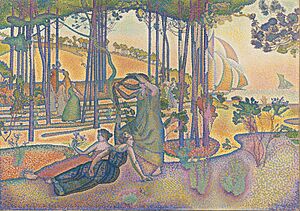
Cross also shared the political ideas of the Neo-Impressionist movement. Like Signac, he believed in anarchist ideas, hoping for a perfect society. In 1896, Cross made a lithograph print called L'Errant (The Wanderer). This print was published anonymously in Les Temps Nouveaux, an anarchist journal. Cross's beliefs influenced his art. He painted scenes that showed a peaceful, ideal world that he imagined could exist.
Creating Divisionist paintings with many small dots of color was a very slow process. When Cross wanted to capture quick ideas, he used watercolors or colored pencils in his sketchbooks. He once wrote about a bike ride:
"Oh! What I saw in a split second while riding my bike tonight! I just had to jot down these fleeting things... a rapid notation in watercolor and pencil: an informal daubing of contrasting colors, tones, and hues, all packed with information to make a lovely watercolor the next day in the quiet leisure of the studio."
Later Years and Influence
Cross's paintings from the early to mid-1890s used the Pointillist style, with tiny, closely placed dots of color. Around 1895, he slowly changed his technique. He started using wider, blocky brushstrokes and left small areas of bare canvas between them. This made his paintings look like mosaics. These works are seen as early examples of Fauvism and Cubism. In Pointillism, tiny dots blend colors smoothly. But in his later "second generation Neo-Impressionism," he kept colors separate. This created "vibrant shimmering visual effects through contrast." Cross said that Neo-Impressionists wanted to create "harmonies of pure color" rather than just copying nature. Artists like Matisse were very influenced by Cross's later work, which helped shape the ideas of Fauvism. Other artists influenced by Cross included André Derain, Henri Manguin, and Louis Valtat.
In 1905, Cross had his first solo art show at Galerie Druet in Paris. It featured thirty paintings and thirty watercolors. The show was very successful, and most of his works were sold. A Belgian poet named Emile Verhaeren wrote the introduction for the show's catalog, saying:
"These landscapes... are not merely pages of sheer beauty, but motifs embodying a lyrical sense of emotion. Their rich harmonies are satisfying to the painter’s eye, and their sumptuous, luxuriant vision is a poet's delight. Yet this abundance never tips into excess. Everything is light and charming..."
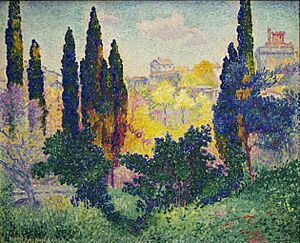
From the early 1880s, Cross began to have eye problems, which got worse in the 1900s. He also suffered more and more from arthritis. Because of these health issues, he didn't create a huge number of works. However, in his last years, he was very productive and creative. His work was shown in important solo exhibitions, and he received great praise from art critics and sold many paintings.
In 1909, Cross was treated for cancer in a Paris hospital. In January 1910, he returned to Saint-Clair. He died there from cancer on May 16, 1910, just four days before his 54th birthday. His tomb in the Le Lavandou cemetery has a bronze medallion designed by his friend Théo van Rysselberghe. In July 1911, his hometown of Douai held a special exhibition of his work.
Selected Exhibitions
Henri-Edmond Cross participated in many art exhibitions during his life. He was invited by Octave Maus to show his work in several of the Annual Exhibitions of Les XX. He also took part in the Libre Esthétique shows in 1895, 1897, 1901, 1904, 1908, and 1909.
In 1898, he, along with Paul Signac, Maximilien Luce, and Théo van Rysselberghe, participated in the first Neo-Impressionist exhibition in Germany. In 1907, Félix Fénéon put together a special show of Cross's work in Paris at Galerie Bernheim-Jeune. Other places that showed Cross's art included Samuel Bing's L'Art Nouveau à Paris, Galerie Durand-Ruel (Paris), Cassirer Gallery (Hamburg, Berlin), and various galleries in Paris, Dresden, Weimar, and Munich.
Gallery
Collections
Cross's paintings can be found in many museums and public art galleries around the world:
- Allen Memorial Art Museum (Oberlin College, Ohio)
- Art Institute of Chicago
- Barnes Foundation (Philadelphia, Pennsylvania)
- Block Museum of Art (Northwestern University, Evanston, Illinois)
- Brooklyn Museum (New York City)
- Cleveland Museum of Art
- Fine Arts Museums of San Francisco
- Finnish National Gallery (Helsinki, Finland)
- Harvard University Art Museums
- Hermitage Museum (Saint Petersburg, Russia)
- Honolulu Museum of Art
- Indianapolis Museum of Art
- Kröller-Müller Museum
- Kunstmuseum Basel (Switzerland)
- Los Angeles County Museum of Art
- Metropolitan Museum of Art (New York City)
- Museum Barberini (Potsdam, Germany)
- Museum of Grenoble (Grenoble, France)
- Musée d'Orsay (Paris)
- Musée Malraux (Le Havre, France)
- Musée Richard Anacréon (Granville, France)
- Museum of Modern Art (New York City)
- National Gallery of Art (Washington D.C.)
- New Art Gallery (Walsall, England)
- Statens Museum for Kunst (National Gallery of Denmark, Copenhagen)
- Tel Aviv Museum of Art
- Thyssen-Bornemisza Museum (Madrid)
- Wallraf-Richartz-Museum (Cologne, Germany)
See also
 In Spanish: Henri-Edmond Cross para niños
In Spanish: Henri-Edmond Cross para niños




